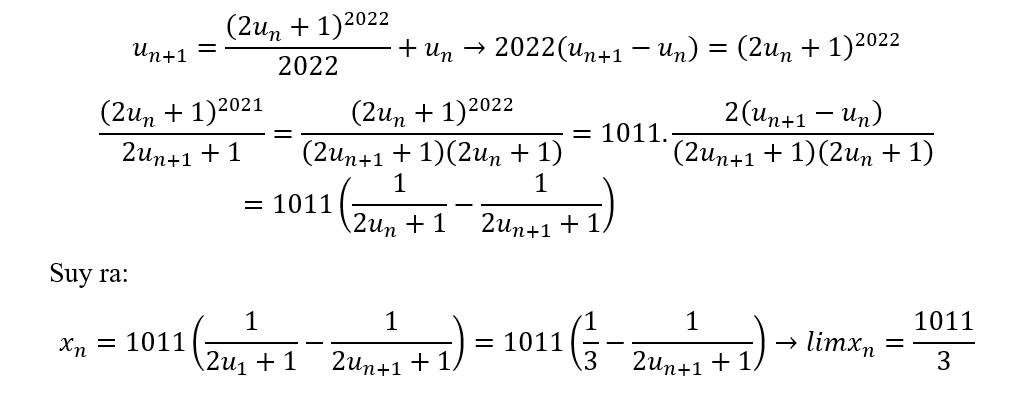Hãy nhập câu hỏi của bạn vào đây, nếu là tài khoản VIP, bạn sẽ được ưu tiên trả lời.

Đề chỗ này có vấn đề:
\(u_n^2+2021u_n-2023u_{n+1}+1\)
Thiếu dấu "="

\(a,f'\left(x\right)=3x^2-6x\\ f'\left(x\right)\le0\Leftrightarrow3x^2-6x\le0\\ \Leftrightarrow3x\left(x-2\right)\le0\Leftrightarrow0\le x\le2\)
Lời giải:
a. $f'(x)\leq 0$
$\Leftrightarrow 3x^2-6x\leq 0$
$\Leftrightarrow x(x-2)\leq 0$
$\Leftrightarrow 0\leq x\leq 2$
b.
$f'(x)=x^2-3x+2=0$
$\Leftrightarrow 3x^2-6x=x^2-3x+2=0$
$\Leftrightarrow 3x(x-2)=(x-1)(x-2)=0$
$\Leftrightarrow x-2=0$
$\Leftrightarrow x=2$
c.
$g(x)=f(1-2x)+x^2-x+2022$
$g'(x)=(1-2x)'f(1-2x)'_{1-2x}+2x-1$
$=-2[3(1-2x)^2-6(1-2x)]+2x-1$
$=-24x^2+2x+5$
$g'(x)\geq 0$
$\Leftrightarrow -24x^2+2x+5\geq 0$
$\Leftrightarrow (5-12x)(2x-1)\geq 0$
$\Leftrightarrow \frac{-5}{12}\leq x\leq \frac{1}{2}$

Đặt \(f\left(x\right)=m\left(x-1\right)^{2022}\left(x^2-9\right)+x^2-2\) liên tục trên R
\(\Rightarrow f\left(x\right)\) liên tục trên [-3;1] và [1;3]
\(\Rightarrow\left\{{}\begin{matrix}f\left(1\right)=-1\\f\left(3\right)=7\\f\left(-3\right)=7\end{matrix}\right.\) \(\Rightarrow f\left(1\right)f\left(-3\right)< 0;f\left(3\right).f\left(1\right)< 0\)
\(\Rightarrow\) Tồn tại ít nhất 1 no x \(\in\left(-3;1\right)\) và 1 no x \(\in\) ( 1 ; 3 ) để f(x) = 0 \(\forall m\)
\(\Rightarrow\) p/t có ít nhất 2 no \(\forall m\) (đpcm)

\(\Leftrightarrow4sin^{2020}x\left(1-2sin^2x\right)=4cos^{2020}x\left(2cos^2x-1\right)+5cos2x=0\)
\(\Leftrightarrow4sin^{2020}x.cos2x=4cos^{2020}x.cos2x+5cos2x\)
\(\Leftrightarrow\left[{}\begin{matrix}cos2x=0\Rightarrow x=...\\4sin^{2020}x=4cos^{2020}x+5\left(1\right)\end{matrix}\right.\)
Xét (1), ta có \(\left\{{}\begin{matrix}4sin^{2020}x\le4\\4cos^{2020}x+5\ge5\end{matrix}\right.\)
\(\Rightarrow4sin^{2020}x< 4cos^{2020}x+5\) với mọi x
\(\Rightarrow\left(1\right)\) vô nghiệm

\(a,1^{1,5}=1;3^{-1}=\dfrac{1}{3};\left(\dfrac{1}{2}\right)^{-2}=4\\ \Rightarrow\dfrac{1}{3}< 1< 4\\ b,2022^0=1;\left(\dfrac{4}{5}\right)^{-1}=\dfrac{5}{4};5^{\dfrac{1}{2}}=\sqrt{5}\simeq2,24\\ \Rightarrow1< \dfrac{5}{4}< \sqrt{5}\)

Xét hàm số \(f\left(x\right)=\dfrac{x^{2022}+3x+16}{x^{2021}-x+11}\), ta cần cm
\(f\left(x\right)\ge x\) (*)
Thật vậy, (*) \(\Leftrightarrow x^{2022}+3x+16\ge x^{2022}-x^2+11x\)
\(\Leftrightarrow x^2-8x+16\ge0\)
\(\Leftrightarrow\left(x-4\right)^2\ge0\) (luôn đúng)
Vậy \(f\left(x\right)\ge x,\forall x\)
\(\Rightarrow u_{n+1}=f\left(u_n\right)\ge u_n\) nên \(\left(u_n\right)\) là dãy tăng.

Lời giải:
Ta sẽ đi CM đẳng thức tổng quát:
\((C^1_{2n})^2-(C^2_{2n})^2+(C^3_{2n})^2-....+(C^{2n-1}_{2n})^2-(C^{2n}_{2n})^2=C^n_{2n}+1\) với $n$ lẻ.
Theo nhị thức Newton ta có:
\((x^2-1)^{2n}=C^0_{2n}-C^1_{2n}x^2+C^2_{2n}x^4-....-C^n_{2n}x^{2n}+...+C^{2n}_{2n}x^{4n}\). Trong này, hệ số của $x^{2n}$ là $-C^n_{2n}$
Tiếp tục sử dụng nhị thức Newton:
\((x^2-1)^{2n}=(x+1)^{2n}(x-1)^{2n}=(C^0_{2n}+C^1_{2n}+C^2_{2n}x^2+...+C^{2n}_{2n}x^{2n})(C^0_{2n}x^{2n}-C^1_{2n}x^{2n-1}+C^2_{2n}x^{2n-2}-...+C^{2n}_{2n})\). Trong này, hệ số của $x^{2n}$ là
\((C^0_{2n})^2-(C^1_{2n})^2+(C^2_{2n})^2-.....+(C^{2n}_{2n})^2\)
Do đó:
\(-C^n_{2n}=(C^0_{2n})^2-(C^1_{2n})^2+(C^2_{2n})^2-.....+(C^{2n}_{2n})^2\)
\(\Leftrightarrow -C^n_{2n}=1-(C^1_{2n})^2+(C^2_{2n})^2-.....+(C^{2n}_{2n})^2\)
\(\Leftrightarrow (C^1_{2n})^2-(C^2_{2n})^2+...-(C^2_{2n})^2=1+C^n_{2n}\)
Thay $n=1011$ ta có đpcm.
dcvdx